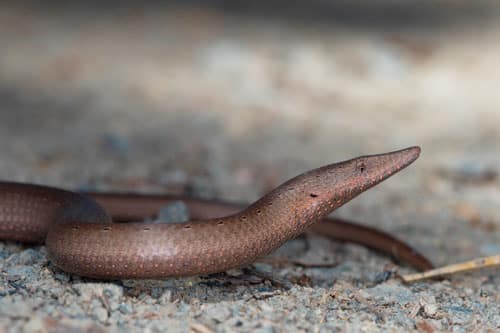Description:
A terrarium measuring about 36 inches long by 12 inches wide is a great start for a single Burton’s legless lizard. Place an undertank heating pad at one end of the enclosure to create a warmer end. This also helps to raise the humidity. Place a few inches of ground coconut coir or cypress bedding into the enclosure, with a large water bowl at the cooler end. This bowl should be large enough for the lizard to completely coil up into. Place a hide in the end where the heat pad is located. Cork bark, a ceramic pot shard or any of the many commercial hides that are available would work well. Add a handful of damp moss to the hide. With the heat pad beneath, it will make a great humid hide for the lizard to hang out in, as well as a great ambush area for when it is hunting. Add some sticks, other hides, decorative bark, a background, plants (plastic or live) — whatever you like. Add a secure screen top and over that, directly over the main hide, place a heat lamp. Use a thermometer to establish a hot spot of about 90 degrees Fahrenheit. Turn this lamp on in the morning and off at night. Add a UVB tube across the entire top of the enclosure; turn it on at dawn and off at dusk. Replenish the moisture in the moss within the hide as needed. Also add water to the substrate to keep the humidity up. A humidity range between 55 and 70 percent is great. Live lizards, or lizards simulated to be alive, should be offered to Burton’s legless lizards. These are visual predators that hunt by sight and motion, and they rarely take mammals in the wild or captivity. House geckos, long-tail lizards and green anoles are usually readily available and make great feeders. Make sure the feeder insects used to feed the feeder lizards are adequately gut loaded (unless you are feeding them Vita Bugs). In the wild, Burton’s legless lizards have also been known to feed on small snakes, but they are primarily lizard eaters, and that’s a pretty simple diet to offer them in captivity. As mentioned, Burton’s legless lizards hunt by sight. They are attracted by movement, so your feeder lizards will need to be live, or jiggled at the end of forceps if pre-killed. What’s Available: To my knowledge, all Burton’s legless lizards that are available are field-collected imports from New Guinea. There are no morphs that I’m aware of. Imports might be dehydrated upon arrival, so care should be made to make sure they are properly hydrated. Worming might be required also, and a good reptile vet will be able to assist you with this if you find you lack the experience to do so yourself. Sporadically imported, Burton’s legless lizards usually arrive in the U.S. all at once in fairly large numbers — or not at all. With this “seasonal” importation, and depending on the time of the year, you may be able to find these fascinating lizards in reptile specialty stores and, sometimes, online or at reptile shows. Burton’s legless lizards are intelligent and easy to care for, with the exception of being lizard eaters. All in all, if you don’t mind feeding reptiles to your pet reptile, they make excellent pets. Burton’s legless lizard is the most widespread lizard in Australia. Like geckos, they have no eyelids. They’re also known as flap-footed lizards because even though they’re known for being “legless” and lack from limbs, they do have a couple of fleshy appendages where their hind legs should be. Ken Foose produced his first captive-bred snakes at age 11. With a Master’s Degree in zoology, he has been both a zookeeper and curator. He opened Exotic Pets, which specializes in reptiles and amphibians, in Las Vegas in 1991. He is currently president of the International Herpetological Symposium.
Habitat:
Wide ranging and diverse habitats, from arid regions near desert areas to tropical dry forests to rain forests. Field edges and areas with leaf litter. Abundant cover is essential.
Range:
All of Australia, except for the very southernmost part, and isolated areas of New Guinea
Scientific Name: Lialis burtonis
Species Group: N/A
Family: Pygopodidae
Size: N/A
Level: advanced
Weight: N/A
Dangerous: No


